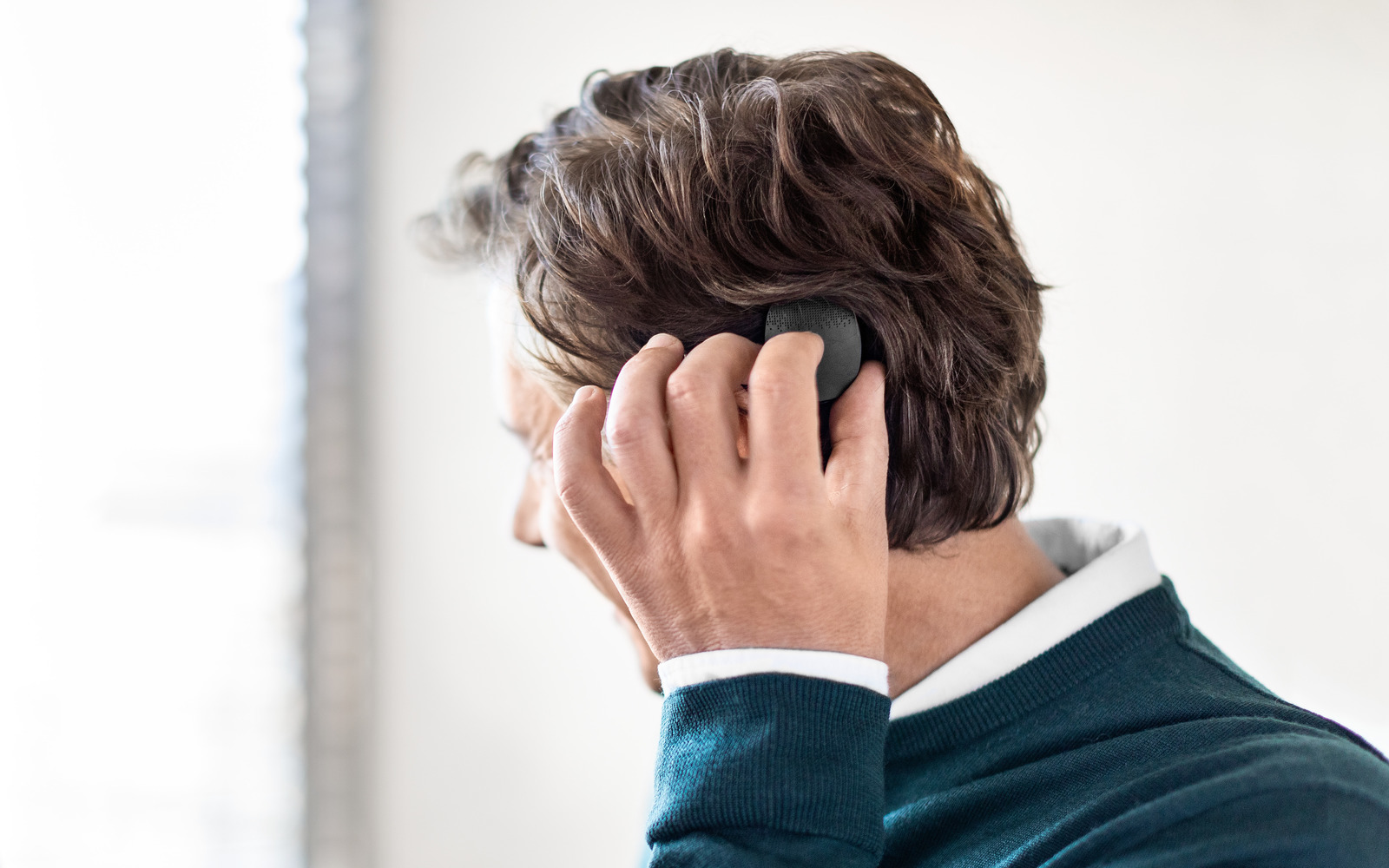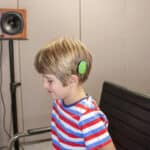
Nathan Schackow
Published Mar 03, 2025
Cochlear Implantation Outcomes in Adults With Unilateral Deafness: Speech Perception, Tinnitus, Sound Localization, and Quality of Life
Cochlear implantation has been shown to improve not only the hearing of thousands of patients with unilateral deafness, but growing evidence now shows that many SSD (single-sided deafness) CI (cochlear implant) users also benefit from improved tinnitus control, sound localization, and quality of life. This article summarizes key findings from recent publications, including systematic literature reviews, meta-analyses, and clinical considerations—that, for the first time, were able to draw on data from a large number of adult SSD-CI patients.

- 1 Speech Perception Outcomes
- 2 Tinnitus Outcomes
- 3 Sound Localization Outcomes
- 4 Quality of Life Outcomes
- 5 Considerations for SSD-CI Candidates & Patients
- 6 CI Candidacy in SSD & Duration of Deafness
- 7 Counseling & Auditory Training
- 8 Optimizing Interaural Pitch Perception
- 9 Reducing Tonotopic Mismatch
- 10 Optimizing Processing Timing
- 11 MED-EL CIs & Unilateral Deafness
People with unilateral deafness, or SSD, experience reduced abilities to understand speech in noise and locate sound sources when compared to those with normal hearing in both ears. In the past, adults with unilateral deafness were often considered to not need hearing technology.
With the realization that SSD is a burden in the daily lives of many affected individuals, CROS hearing aids and bone conduction devices were initially recommended as hearing solutions. However, both types of devices are limited when it comes to spatial hearing, such as understanding speech in noise which originates from a different location from the speaker.
“Cochlear implantation in adults with SSD results in significant improvements in speech perception, tinnitus control, sound localization, and QoL [Quality of Life].”
Oh et al., 2023
In contrast to other hearing devices such as hearing aids, cochlear implants can allow many patients with SSD to significantly improve sound source localization abilities and experience a reduction in tinnitus while also enjoying improved speech in noise understanding and quality of life.Oh, S. J., Mavrommatis, M. A., Fan, C. J., DiRisio, A. C., Villavisanis, D. F., Berson, E. R., Schwam, Z. G., Wanna, G. B., & Cosetti, M. K. (2023). Cochlear Implantation in Adults With Single‐Sided Deafness: A Systematic Review and Meta‐analysis. Otolaryngology–Head and Neck Surgery, 168(2), 131–142. https://doi.org/10.1177/01945998221083283[1]Daher, G. S., Kocharyan, A., Dillon, M. T., & Carlson, M. L. (2023). Cochlear Implantation Outcomes in Adults With Single-Sided Deafness: A Systematic Review and Meta-analysis. Otology & Neurotology, 44(4), 297–309. https://doi.org/10.1097/mao.0000000000003833[2]Dillon, M. T., Kocharyan, A., Daher, G. S., Carlson, M. L., Shapiro, W. H., Snapp, H. A., & Firszt, J. B. (2022). American Cochlear Implant Alliance Task Force Guidelines for Clinical Assessment and Management of Adult Cochlear Implantation for Single-Sided Deafness. Ear and Hearing, 43(6), 1605–1619. https://doi.org/10.1097/aud.0000000000001260 [3]
Clinical Outcomes in Adult SSD-CI Patients
Speech Perception
A systematic review and meta-analysis found 38 studies evaluating speech perception in 499 adults, and 34 of these studies found a statistically significant improvement in speech perception post implantation.Oh, S. J., Mavrommatis, M. A., Fan, C. J., DiRisio, A. C., Villavisanis, D. F., Berson, E. R., Schwam, Z. G., Wanna, G. B., & Cosetti, M. K. (2023). Cochlear Implantation in Adults With Single‐Sided Deafness: A Systematic Review and Meta‐analysis. Otolaryngology–Head and Neck Surgery, 168(2), 131–142. https://doi.org/10.1177/01945998221083283[1] “Five studies had sufficient data to be included in the meta-analysis. Speech understanding was found to improve significantly from pre- to postoperative test administration.”Oh, S. J., Mavrommatis, M. A., Fan, C. J., DiRisio, A. C., Villavisanis, D. F., Berson, E. R., Schwam, Z. G., Wanna, G. B., & Cosetti, M. K. (2023). Cochlear Implantation in Adults With Single‐Sided Deafness: A Systematic Review and Meta‐analysis. Otolaryngology–Head and Neck Surgery, 168(2), 131–142. https://doi.org/10.1177/01945998221083283[1]
This confirmed the findings of an earlier systematic review:
“A high probability of improvement (>75 to 100%) was observed for speech recognition in quiet for the CI-ear, indicating a significant improvement in speech recognition in the impaired ear with CI use. For speech recognition in noise in the CI+NH [normal hearing] condition, there was a high probability of improvement (>75 to 100%) for the S0Nnh, SciN0, and SciNnh [testing] configurations.”
Dillon et al., 2022
The review, however, did note that the probability of significant improvement in speech recognition in noise testing results depended on the testing configuration, which also varied across studies.Dillon, M. T., Kocharyan, A., Daher, G. S., Carlson, M. L., Shapiro, W. H., Snapp, H. A., & Firszt, J. B. (2022). American Cochlear Implant Alliance Task Force Guidelines for Clinical Assessment and Management of Adult Cochlear Implantation for Single-Sided Deafness. Ear and Hearing, 43(6), 1605–1619. https://doi.org/10.1097/aud.0000000000001260 [3]
In addition, one study found that speech perception and binaural hearing can continue to improve until at least five years after CI.Thompson, N. J., Brown, K. D., Buss, E., Rooth, M. A., Richter, M. E., & Dillon, M. T. (2023). Long‐Term Binaural Hearing Improvements for Cochlear Implant Users with Asymmetric Hearing Loss. The Laryngoscope, 133(6), 1480–1485. https://doi.org/10.1002/lary.30368[4] Future studies are needed to confirm the length of time in which speech perception continues to improve.
Tinnitus
An analysis of 21 studies measuring tinnitus in 369 patients found a statistically significant mean reduction in tinnitus post implantation, with all of the studies reporting significant tinnitus improvements with CI.Oh, S. J., Mavrommatis, M. A., Fan, C. J., DiRisio, A. C., Villavisanis, D. F., Berson, E. R., Schwam, Z. G., Wanna, G. B., & Cosetti, M. K. (2023). Cochlear Implantation in Adults With Single‐Sided Deafness: A Systematic Review and Meta‐analysis. Otolaryngology–Head and Neck Surgery, 168(2), 131–142. https://doi.org/10.1177/01945998221083283[1]
The studies also found clinically relevant improvements in tinnitus, meaning that—in addition to a statistically significant benefit—subjective positive benefits were also reported by the patients.
“Seven studies had sufficient data for meta-analysis. Unilateral CI was associated with a statistically significant reduction in tinnitus.”Oh, S. J., Mavrommatis, M. A., Fan, C. J., DiRisio, A. C., Villavisanis, D. F., Berson, E. R., Schwam, Z. G., Wanna, G. B., & Cosetti, M. K. (2023). Cochlear Implantation in Adults With Single‐Sided Deafness: A Systematic Review and Meta‐analysis. Otolaryngology–Head and Neck Surgery, 168(2), 131–142. https://doi.org/10.1177/01945998221083283[1]
This confirmed the findings of a previous systematic review with results from 17 publications:
“For subjective measures of tinnitus severity, there was a high probability of a significant reduction (>75 to 100%) in tinnitus severity when listening with the CI."
Dillon et al., 2022
Regarding the length of time over which improvement continues, one study found a “significant reduction in perceived tinnitus severity and improvement in quality of life with CI use that is generally maintained with long-term device use” until at least five years post implantation.Thompson, N. J., Lopez, E. M., Dillon, M. T., Rooth, M. A., Richter, M. E., Pillsbury, H. C., & Brown, K. D. (2023). Cochlear Implantation for Unilateral and Asymmetric Hearing Loss: Long‐Term Subjective Benefit. The Laryngoscope, 133(10), 2792–2797. https://doi.org/10.1002/lary.30608[5]
Sound Localization
An analysis found 27 studies investigating sound localization outcomes in 232 adult SSD-CI patients, and 24 studies reported a significant improvement post implantation.Oh, S. J., Mavrommatis, M. A., Fan, C. J., DiRisio, A. C., Villavisanis, D. F., Berson, E. R., Schwam, Z. G., Wanna, G. B., & Cosetti, M. K. (2023). Cochlear Implantation in Adults With Single‐Sided Deafness: A Systematic Review and Meta‐analysis. Otolaryngology–Head and Neck Surgery, 168(2), 131–142. https://doi.org/10.1177/01945998221083283[1]
“Seven studies had sufficient data to be included in meta-analysis. Collectively, unilateral CI was associated with an improvement in sound localization.”Oh, S. J., Mavrommatis, M. A., Fan, C. J., DiRisio, A. C., Villavisanis, D. F., Berson, E. R., Schwam, Z. G., Wanna, G. B., & Cosetti, M. K. (2023). Cochlear Implantation in Adults With Single‐Sided Deafness: A Systematic Review and Meta‐analysis. Otolaryngology–Head and Neck Surgery, 168(2), 131–142. https://doi.org/10.1177/01945998221083283[1]
Additionally, when the long-term sound localization abilities of adult CI users with SSD were examined, it was found that:
“The present sample demonstrated significant improvements between the 1-year and 5-year visits, with greater accuracy and consistency noted in their response patterns.”Thompson, N. J., Dillon, M. T., Buss, E., Rooth, M. A., Richter, M. E., Pillsbury, H. C., & Brown, K. D. (2022). Long‐Term Improvement in Localization for Cochlear Implant Users with Single‐Sided Deafness. The Laryngoscope, 132(12), 2453–2458. https://doi.org/10.1002/lary.30065[6]
Thus, cochlear implant recipients saw an improvement in their ability to locate sound sources, and this improvement continued up to five years after implantation.
Quality of Life
The analysis included 22 studies that measured Quality of Life (QoL) outcomes in 422 adults, and 21 of these studies reported a significant improvement in QoL.Oh, S. J., Mavrommatis, M. A., Fan, C. J., DiRisio, A. C., Villavisanis, D. F., Berson, E. R., Schwam, Z. G., Wanna, G. B., & Cosetti, M. K. (2023). Cochlear Implantation in Adults With Single‐Sided Deafness: A Systematic Review and Meta‐analysis. Otolaryngology–Head and Neck Surgery, 168(2), 131–142. https://doi.org/10.1177/01945998221083283[1]
“Eight studies had sufficient data for meta-analysis of QoL outcomes. Collectively, these studies showed an improvement … in QoL score with unilateral CI.”Oh, S. J., Mavrommatis, M. A., Fan, C. J., DiRisio, A. C., Villavisanis, D. F., Berson, E. R., Schwam, Z. G., Wanna, G. B., & Cosetti, M. K. (2023). Cochlear Implantation in Adults With Single‐Sided Deafness: A Systematic Review and Meta‐analysis. Otolaryngology–Head and Neck Surgery, 168(2), 131–142. https://doi.org/10.1177/01945998221083283[1]
In addition, the findings summarized above were consistent with those from a subsequent systematic review and meta-analysis that included 36 studies evaluating CI use in 796 adults with SSD.
“Cochlear implantation and CI use consistently offer improvements in speech recognition in noise, sound source localization, tinnitus, and perceived quality of life in adults with SSD.”
Daher et al., 2023
Thus, the benefits of cochlear implantation for adults with unilateral deafness are now well-established. Nevertheless, there are still several important considerations for clinicians to keep in mind when considering CI candidacy and working with this unique patient population.
Considerations: Cochlear Implants & Adults With Unilateral Deafness

Duration of Deafness & CI Candidacy for Patients With Unilateral Deafness
The first consideration is related to duration of deafness prior to CI. One study compared speech perception outcomes in two groups of adults who acquired SSD postlingually. The first group had prolonged deafness of over ten years, and the second group had a duration of deafness less than ten years. The study concluded that:
“Adult CI recipients with acquired SSD, with and without prolonged auditory deprivation, demonstrated comparable speech perception scores. Prolonged duration of deafness alone should not preclude a motivated SSD patient from undergoing cochlear implantation.”
Nassiri et al., 2022
These findings were later confirmed by another study which found that a long duration of deafness “should not generally be considered as contraindication” to cochlear implantation for adults with unilateral deafness.Rader, T., Waleka, O. J., Strieth, S., Eichhorn, K. W. G., Bohnert, A., Koutsimpelas, D., Matthias, C., & Ernst, B. P. (2023). Hearing rehabilitation for unilateral deafness using a cochlear implant: the influence of the subjective duration of deafness on speech intelligibility. European Archives of Oto-Rhino-Laryngology, 280(2), 651–659. https://doi.org/10.1007/s00405-022-07531-3[7]
However, important differences exist between patients with congenital SSD and those who acquired SSD postlingually.
“Additional consideration is recommended for an adult with congenital SSD onset. Prolonged duration of deafness combined with congenital SSD onset may result in limited CI outcomes.”
Dillon et al., 2022
MED-EL: The World Leader & Pioneers in SSD Treatment
- In 2013, MED-EL was the first CI manufacturer in the world to receive the CE mark for SSD, highlighting its leadership in expanding the candidacy for cochlear implants in Europe.Dhanasingh, A., & Hochmair, I. (2021). CI in single-sided deafness. Acta Oto-Laryngologica, 141(sup1), 82–105. https://doi.org/10.1080/00016489.2021.1888496 [14]
- In 2019, MED-EL cochlear implants were the first to receive FDA approval for treating single-sided deafness (SSD) and asymmetric hearing loss in the United States.US Food & Drug Administration. (2019). Premarket approval, MED-EL Cochlear Implant System. PMA P000025/S104: SUMMARY OF SAFETY AND EFFECTIVENESS DATA (SSED). https://www.accessdata.fda.gov/scripts/cdrh/cfdocs/cfpma/pma.cfm?id=P000025S104[15]Hearing Health Matters. (2019). FDA approves MED-EL cochlear implant systems for Single-Sided deafness and asymmetric hearing loss. Hearing Health & Technology Matters. https://hearinghealthmatters.org/hearing-technologies/2019/cochlear-implant-single-sided-deafness-fda-approval-med-el/[16]
Reaching these milestones has helped pave the way for the entire hearing technology industry to move forward worldwide, with MED-EL continuing to lead and drive innovation.
Counseling & Auditory Training for SSD-CI Patients
The second set of considerations relates to expectations and recipient behavior post implantation. Discussions to set realistic expectations should be included in counseling with CI candidates, specifically regarding auditory training, consistent device usage, and overall wearing time so they can achieve maximum benefit from their CI. After activation, clinicians can observe daily CI use with the help of MAESTRO’s data-logging features.
The American Cochlear Implant Alliance Task Force Guidelines for Clinical Assessment and Management of Adult Cochlear Implantation for Single-Sided Deafness provides more detailed recommendations related to topics such as counseling and systematic auditory training of the implanted ear.Dillon, M. T., Kocharyan, A., Daher, G. S., Carlson, M. L., Shapiro, W. H., Snapp, H. A., & Firszt, J. B. (2022). American Cochlear Implant Alliance Task Force Guidelines for Clinical Assessment and Management of Adult Cochlear Implantation for Single-Sided Deafness. Ear and Hearing, 43(6), 1605–1619. https://doi.org/10.1097/aud.0000000000001260 [3]
Optimizing Interaural Pitch Perception for SSD-CI Patients
Additional considerations need to be made when mixing electric stimulation in one ear with acoustic hearing on the contralateral side.
“For SSD-CI users, interaural place mismatch reflects the relationship between electrode placement and the acoustic tonotopy of the cochlea. … Because SSD-CI binaural sensitivity appears not to adapt to interaural place mismatch, maximizing binaural performance will likely require intervention by adjusting the CI sound processor frequency allocation.”
Bernstein et al., 2021
The authors conclude that reprogramming the cochlear implant frequency allocation based on CT scans, not on interaural pitch, may improve binaural processing and spatial hearing benefits.
The American Cochlear Implant Alliance Task Force Guidelines for Clinical Assessment and Management of Adult Cochlear Implantation for Single-Sided Deafness also noted this as a possibility to improve outcomes in SSD-CI users:
“For CI recipients with SSD, mismatch may be reduced by implantation of a long electrode array that approximates the cochlear place frequency with the default filter frequencies and/or mapping the filter frequencies for individual electrode contacts to match the cochlear place frequencies. Providing electric filter frequencies that approximate the cochlear place frequency may support early acclimatization with the CI (Dillon et al., 2019) and binaural fusion (Wess et al., 2020) .”
Dillon et al., 2022
While the method of providing electric filter frequencies that approximate the cochlear place frequency is still an emerging field of cochlear implant research, many early studies have shown promising results.
One recent study focused on SSD-CI users with postlingual hearing loss, and it concluded that:
“Experienced SSD-CI users preferred using the ABF map [anatomy-based fitting], which gave them significant improvements in binaural hearing and some aspects of speech perception.”
Kurz et al., 2024
Only MED-EL Provides Tools to Reduce Tonotopic Mismatch
Matching the pitch of the electric stimulation from the cochlear implant to the natural acoustic tonotopy of the cochlea is possible. Using OTOPLAN* and CT or plain x-ray imaging data, audiologists can identify the location of each patient’s electrode array after surgery. Based on that information, audiologists can use MAESTRO’s anatomy-based fitting feature to reassign the frequency sent to each electrode and more closely match the natural tuning of each patient’s cochlea.Li, H., Helpard, L., Ekeroot, J., Rohani, S. A., Zhu, N., Rask-Andersen, H., Ladak, H. M., & Agrawal, S. (2021). Three-dimensional tonotopic mapping of the human cochlea based on synchrotron radiation phase-contrast imaging. Scientific Reports, 11(1), 4437. https://doi.org/10.1038/s41598-021-83225-w[11]
This can be done to help match the pitch in the implanted ear to the contralateral ear, whether that ear has natural hearing, a hearing aid, or a second cochlear implant.
Optimizing Processing Timing of the CI With Anatomy-Based Fitting
If your patient uses a hearing aid for acoustic stimulation in the contralateral ear, it is important to synchronize the signal timing between the CI and the acoustic ear. You can do that by using the bimodal synchronization feature in MAESTRO, but you should perform anatomy-based fitting beforehand to ensure that frequency-specific delays are transmitted to each tonotopically-matched place. You can find more details on correcting for timing mismatches with bimodal synchronization of the CI with the hearing aid in the MAESTRO software here.
For SSD-CI users without a hearing aid, the unique CI signal processing of MED-EL cochlear implants is designed to mimic natural hearing with delays that are “similar to those of the unaided ear.”Zirn, S., Arndt, S., Aschendorff, A., & Wesarg, T. (2015). Interaural stimulation timing in single sided deaf cochlear implant users. Hearing research, 328, 148–156. https://doi.org/10.1016/j.heares.2015.08.010[12]
MED-EL Cochlear Implants: Superior Hearing Performance for Patients With Unilateral Deafness
“I want to encourage people to do what they love, whether it is music or something else. Don’t let single-sided deafness, other people, or even you, limit yourself. See your hearing loss, and a cochlear implant, as a journey and a chance!”
Veronika, MED-EL CI Recipient
A MED-EL cochlear implant can help restore the hearing ability to the deafened ear and also provide your patients with unilateral deafness the benefits of binaural hearing which include:
- Improved speech perception in quiet and noise
- Improved spatial hearing
- Continuous improvements in sound localization
Information to share with single-sided deafness cochlear implant candidates can be found here.
For more information about MED-EL cochlear implants for your patients with unilateral deafness and hearing loss, please contact your local MED-EL representative or take a look at our indication criteria for cochlear implant candidacy in single-sided deafness.
Hearing Insights in Your Inbox
Get the latest research and resources to help patients with every kind of hearing loss. Subscribe to the MED-EL Professionals Blog now.
Sign Up Now* OTOPLAN is a product of CASCINATION AG developed in close collaboration with MED-EL. Contact your local MED-EL representative for more information.
References
-
[1]
Oh, S. J., Mavrommatis, M. A., Fan, C. J., DiRisio, A. C., Villavisanis, D. F., Berson, E. R., Schwam, Z. G., Wanna, G. B., & Cosetti, M. K. (2023). Cochlear Implantation in Adults With Single‐Sided Deafness: A Systematic Review and Meta‐analysis. Otolaryngology–Head and Neck Surgery, 168(2), 131–142. https://doi.org/10.1177/01945998221083283
-
[2]
Daher, G. S., Kocharyan, A., Dillon, M. T., & Carlson, M. L. (2023). Cochlear Implantation Outcomes in Adults With Single-Sided Deafness: A Systematic Review and Meta-analysis. Otology & Neurotology, 44(4), 297–309. https://doi.org/10.1097/mao.0000000000003833
-
[3]
Dillon, M. T., Kocharyan, A., Daher, G. S., Carlson, M. L., Shapiro, W. H., Snapp, H. A., & Firszt, J. B. (2022). American Cochlear Implant Alliance Task Force Guidelines for Clinical Assessment and Management of Adult Cochlear Implantation for Single-Sided Deafness. Ear and Hearing, 43(6), 1605–1619. https://doi.org/10.1097/aud.0000000000001260
-
[4]
Thompson, N. J., Brown, K. D., Buss, E., Rooth, M. A., Richter, M. E., & Dillon, M. T. (2023). Long‐Term Binaural Hearing Improvements for Cochlear Implant Users with Asymmetric Hearing Loss. The Laryngoscope, 133(6), 1480–1485. https://doi.org/10.1002/lary.30368
-
[5]
Thompson, N. J., Lopez, E. M., Dillon, M. T., Rooth, M. A., Richter, M. E., Pillsbury, H. C., & Brown, K. D. (2023). Cochlear Implantation for Unilateral and Asymmetric Hearing Loss: Long‐Term Subjective Benefit. The Laryngoscope, 133(10), 2792–2797. https://doi.org/10.1002/lary.30608
-
[6]
Thompson, N. J., Dillon, M. T., Buss, E., Rooth, M. A., Richter, M. E., Pillsbury, H. C., & Brown, K. D. (2022). Long‐Term Improvement in Localization for Cochlear Implant Users with Single‐Sided Deafness. The Laryngoscope, 132(12), 2453–2458. https://doi.org/10.1002/lary.30065
-
[7]
Rader, T., Waleka, O. J., Strieth, S., Eichhorn, K. W. G., Bohnert, A., Koutsimpelas, D., Matthias, C., & Ernst, B. P. (2023). Hearing rehabilitation for unilateral deafness using a cochlear implant: the influence of the subjective duration of deafness on speech intelligibility. European Archives of Oto-Rhino-Laryngology, 280(2), 651–659. https://doi.org/10.1007/s00405-022-07531-3
-
[8]
Bernstein, J. G. W., Jensen, K. K., Stakhovskaya, O. A., Noble, J. H., Hoa, M., Kim, H. J., Shih, R., Kolberg, E., Cleary, M., & Goupell, M. J. (2021). Interaural Place-of-Stimulation Mismatch Estimates Using CT Scans and Binaural Perception, But Not Pitch, Are Consistent in Cochlear-Implant Users. The Journal of Neuroscience, 41(49), 10161–10178. https://doi.org/10.1523/jneurosci.0359-21.2021
-
[9]
Dillon, M. T., Buss, E., Rooth, M. A., King, E. R., Pillsbury, H. C., & Brown, K. D. (2019). Low-Frequency Pitch Perception in Cochlear Implant Recipients With Normal Hearing in the Contralateral Ear. Journal of Speech, Language, and Hearing Research : JSLHR, 62(8), 2860–2871. https://doi.org/10.1044/2019_jslhr-h-18-0409
-
[10]
Wess, J. M., Spencer, N. J., & Bernstein, J. G. W. (2020). Counting or discriminating the number of voices to assess binaural fusion with single-sided vocoders. The Journal of the Acoustical Society of America, 147(1), 446–458. https://doi.org/10.1121/10.0000511
-
[11]
Li, H., Helpard, L., Ekeroot, J., Rohani, S. A., Zhu, N., Rask-Andersen, H., Ladak, H. M., & Agrawal, S. (2021). Three-dimensional tonotopic mapping of the human cochlea based on synchrotron radiation phase-contrast imaging. Scientific Reports, 11(1), 4437. https://doi.org/10.1038/s41598-021-83225-w
-
[12]
Zirn, S., Arndt, S., Aschendorff, A., & Wesarg, T. (2015). Interaural stimulation timing in single sided deaf cochlear implant users. Hearing research, 328, 148–156. https://doi.org/10.1016/j.heares.2015.08.010
-
[13]
Kurz, A., Herrmann, D., Müller-Graff, F. T., Voelker, J., Hackenberg, S., & Rak, K. (2025). Anatomy-based fitting improves speech perception in noise for cochlear implant recipients with single-sided deafness. European Archives of Oto-Rhino-Laryngology, 282(1), 467-479. https://doi.org/10.1007/s00405-024-08984-4
-
[14]
Dhanasingh, A., & Hochmair, I. (2021). CI in single-sided deafness. Acta Oto-Laryngologica, 141(sup1), 82–105. https://doi.org/10.1080/00016489.2021.1888496
-
[15]
US Food & Drug Administration. (2019). Premarket approval, MED-EL Cochlear Implant System. PMA P000025/S104: SUMMARY OF SAFETY AND EFFECTIVENESS DATA (SSED). https://www.accessdata.fda.gov/scripts/cdrh/cfdocs/cfpma/pma.cfm?id=P000025S104
-
[16]
Hearing Health Matters. (2019). FDA approves MED-EL cochlear implant systems for Single-Sided deafness and asymmetric hearing loss. Hearing Health & Technology Matters. https://hearinghealthmatters.org/hearing-technologies/2019/cochlear-implant-single-sided-deafness-fda-approval-med-el/
References

Nathan Schackow, MA
Nathan is part of the MED-EL Professionals Blog editorial team. With a background as an English lecturer, Nathan has specialized in writing about innovations in hearing technology and care since 2020. His passion lies in translating complex science into clear, accessible communication that helps inform, inspire, and improve lives.
Was this article helpful?
Thanks for your feedback.
Sign up for newsletter below for more.
Thanks for your feedback.
Please leave your message below.
CTA Form Success Message
Send us a message
Field is required
John Doe
Field is required
name@mail.com
Field is required
What do you think?
The content on this website is for general informational purposes only and should not be taken as medical advice. Please contact your doctor or hearing specialist to learn what type of hearing solution is suitable for your specific needs. Not all products, features, or indications shown are approved in all countries.

Nathan Schackow, MA
Nathan is part of the MED-EL Professionals Blog editorial team. With a background as an English lecturer, Nathan has specialized in writing about innovations in hearing technology and care since 2020. His passion lies in translating complex science into clear, accessible communication that helps inform, inspire, and improve lives.



